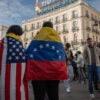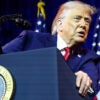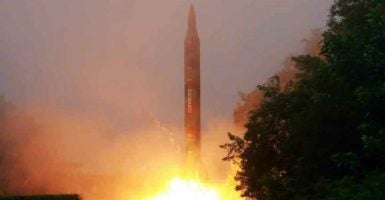North Korea provocatively conducted missile tests on Wednesday, a clear warning to the United States and its allies that nuclear defense systems must remain a priority.
North Korea launched one Scud and two No Dong missiles 500-600 kilometers and announced it was a practice drill for preemptive nuclear attacks on South Korea and U.S. forces based there. Pyongyang has conducted an unprecedented number of missile launches this year to refine its ability to target with nuclear weapons South Korea, Japan, Guam, and U.S. forces stationed in the western Pacific.
Seoul recently agreed to the deployment of the U.S. THAAD (Terminal High Altitude Area Defense) missile defense system to augment protection from North Korea’s growing missile threat. The advanced defense system is more capable than any system that South Korea has or would have for decades. The planned allied deployment has triggered Chinese economic, diplomatic, and military threats even though the defensive system would not impact Chinese security interests and is in response to Beijing’s North Korean ally provocations and threats.
Domestic South Korean critics have mischaracterized the missile defense system’s capabilities, simultaneously arguing that the system is both too effective and too ineffective to be deployed. South Korean critics also issued erroneous warnings of health dangers from the defense shield’s radar without providing any evidence for their claims.
North Korea’s Growing Missile Threat. North Korea state media announced that the recent missile launches were conducted “under the simulated conditions of making preemptive strikes at ports and airfields in the operational theater in South Korea where the U.S. imperialists’ nuclear war hardware is to be hurled [to examine] the operational features of the detonating devices of nuclear warheads mounted on the ballistic rockets at a designated altitude over the target area.”
A North Korean media-released photo showed the missile range would encompass all of South Korea, including the port of Busan where U.S. reinforcement forces would land. In March, Kim Jong-un observed simulating a nuclear missile attack on South Korean targets. The regime declared those launches were “a sea port of debarkation ballistic missile test [conducted] under the simulated conditions of exploding nuclear warheads from the preset altitude above targets in the ports under the enemy control where foreign aggressor forces are involved.”
Shortly after he assumed power in late 2011, North Korean leader Kim directed the creation of a new war plan to complete an invasion of South Korea within a week using asymmetric capabilities including nuclear weapons and missiles. A senior North Korean military defector indicated the North intends to occupy the entire South Korean territory within seven days before U.S. reinforcements arrive.
Improving Allied Defenses. Washington and Seoul announced their joint decision to deploy the THAAD ballistic missile defense system to augment allied missile defenses. The advanced missile defense shield would provide a more reliable layered security at a greater range and higher altitude than existing or planned South Korean systems and enable multiple attempted shots at incoming missiles.
Beijing claims that missile defense deployment would be against China’s security interests, overlooking, of course, that North Korean development of nuclear weapons and missiles—and the repeated threats to use them—go against South Korean and U.S. security interests. A careful analysis of THAAD interceptor and radar capabilities and Chinese missile deployment sites reveal Chinese technical objections are disingenuous. Beijing’s true objective is preventing improvement in allied defensive capabilities and multilateral cooperation.
South Korea critics claim fears of radiation risks from the missile shield’s radar, saying it would kill bees and irradiate melons. The U.S. invited South Korean media to the missile shield’s deployment site on Guam for independent tests. Measured levels of the electromagnetic waves emanating from the radar revealed the system operates at an intensity far safer than required by Korean law, i.e. the radar emitted only 0.007 percent of the 10 watts per square meter allowed under Korean standards. Rep. Madeleine Bordallo, D-Guam, told South Korean reporters that there have been no signs of environmental impact nor any noise complaints from the defense system’s deployment on the island.
Critics fail to understand that North Korea will continue to develop nuclear-tipped missiles regardless of whether the advanced defense system is deployed or not. If THAAD were to intercept even one North Korean nuclear missile, it would save hundreds of thousands of South Korean and U.S. lives.































